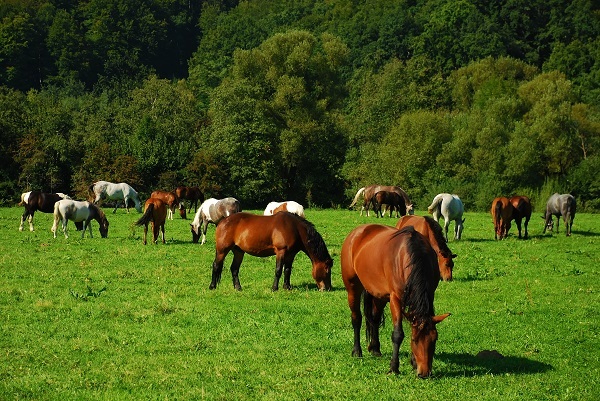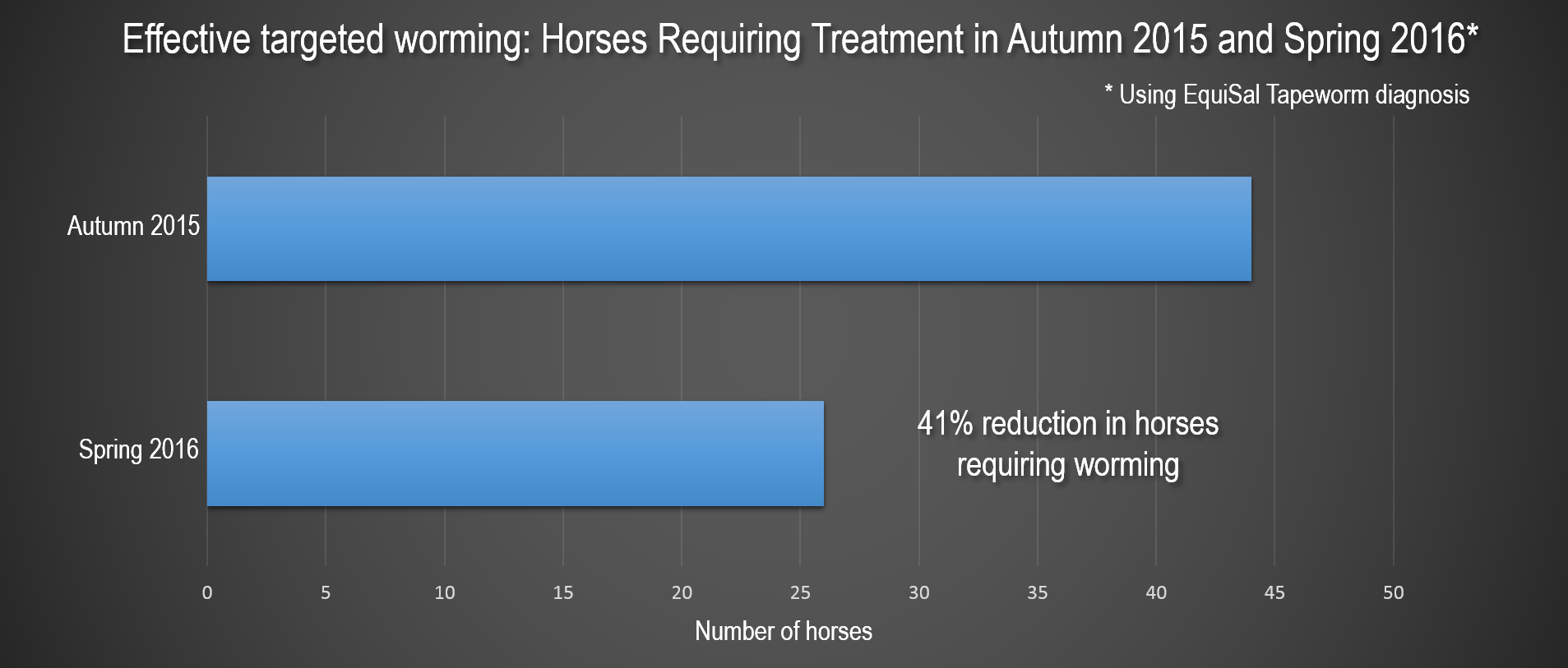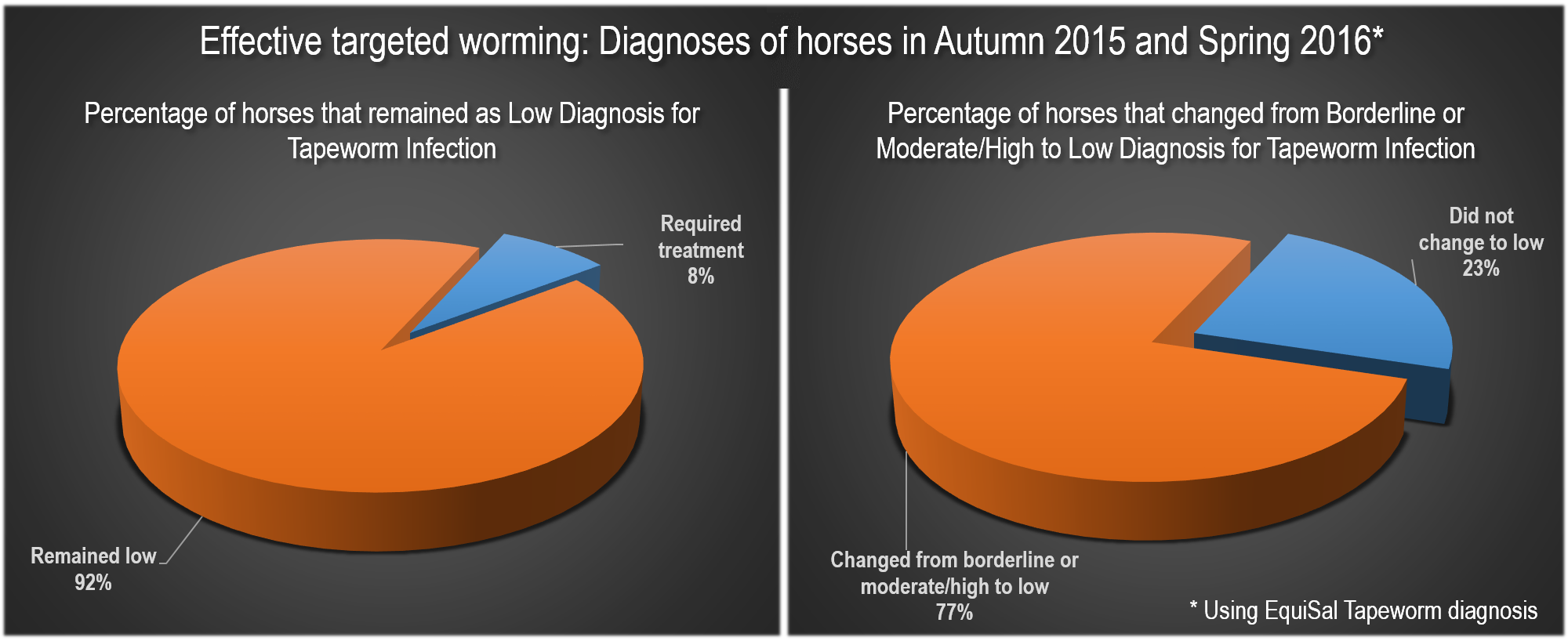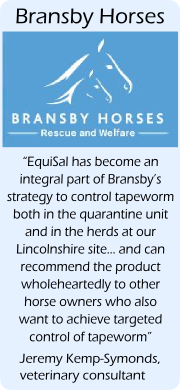Home News and Research Effective targeted worming in herds
Effective targeted worming in herds
Effective targeted worming to control tapeworm infections in herds
Dr Corrine Austin (May 2016)
In summary
Bransby Horses have been using EquiSal Tapeworm testing to enable targeted worming for tapeworm within their herds (currently 303 horses). After testing with EquiSal Tapeworm in Autumn 2015, only horses diagnosed as borderline or moderate/high were treated. Routine testing 6 months later generated very favourable results, with a reduction (41%) in the number of horses requiring treatment. Most of the horses (92%) originally diagnosed as low, remained low 6 months later and the majority of horses (77%) that required treatment in Autumn 2015 were diagnosed as low in Spring 2016. This study supports the use of targeting worming for tapeworm using EquiSal Tapeworm for diagnosis.
Horses and Premises
A total of 303 horses and ponies, owned and managed by Bransby Horses Rescue and Welfare, are kept within 28 different fields across 4 main yards. The fields are maintained using a variety of different means, including muck collection using mechanical and manual methods, resting of certain paddocks as well as no muck collection in some fields. All horses and ponies are regularly weighed on a weighbridge and detailed medical records are kept. All horses were tested with EquiSal Tapeworm in Autumn 2015 and Spring 2016 and only those diagnosed as borderline or moderate/high were treated for tapeworm using praziquantel based products, therefore employing a targeted worming approach to tapeworm infection control.
Bransby Horses Rescue and Welfare, are kept within 28 different fields across 4 main yards. The fields are maintained using a variety of different means, including muck collection using mechanical and manual methods, resting of certain paddocks as well as no muck collection in some fields. All horses and ponies are regularly weighed on a weighbridge and detailed medical records are kept. All horses were tested with EquiSal Tapeworm in Autumn 2015 and Spring 2016 and only those diagnosed as borderline or moderate/high were treated for tapeworm using praziquantel based products, therefore employing a targeted worming approach to tapeworm infection control.
Of the 303 horses tested in Spring 2016, 78% were constant herd members (235) since Autumn 2015. During this time period, 72 horses left the premises and 70 horses joined. Of the 70 horses that joined the herds, 31% required treatment (Table 1).
Analysis of EquiSal Tapeworm diagnosis
To investigate the effectiveness of targeted worming for tapeworm within herds, the results for constant herd members in Autumn 2015 and Spring 2016 were analysed.
The following key observations were noted (detail can be seen in Tables 2 and 3):
- Only 11% of the constant herd members required treatment for tapeworm in Spring 2016 compared with 19% in Autumn 2015. This represents a 41% reduction of horses that required treatment in Spring 2016 (Figure 1).
- 92% of horses diagnosed as low in Autumn 2015 remained low in Spring 2016 (Figure 2).
- 77% of horses requiring treatment in Autumn 2015 had changed to low in Spring 2016 (Figure 2).
- Only 3 horses diagnosed as moderate/high in Autumn 2015 remained moderate/high in Spring 2016.
Outcome
The data presented here provides evidence for effective targeting of tapeworm treatment to individual herd members and demonstrates an overall reduction in numbers of horses requiring treatment within the herds.
Tables and Figures
| Autumn 2015 | Summer 2016 | |
|---|---|---|
| Total number of horses tested | 305 | 303 |
| Number of new horses since Autumn 2015 | 70 | |
| Number of horses left since Autumn 2015 | 72 |
| Number of constant herd members | Autumn 2015 | Spring 2016 |
| Low diagnosis | 191 | 209 |
| Borderline or moderate/high diagnosis | 44 | 26 |
| Total | 235 | 235 |
| Diagnosis in 2015 |
Diagnosis in 2016
|
Number of horses |
| Low | Low | 175 |
| Borderline or moderate/high | Low | 34 |
| Low | Borderline or moderate/high | 16 |
| Borderline or moderate/high | Borderline or moderate/high | 10 |
| Moderate/high | Moderate/high | 3 |

Figure 1. Number of constant herd members requiring treatment in Autumn 2015 and Spring 2016

Figure 2. EquiSal Tapeworm diagnoses of constant herd members between Autumn 2015 and Spring 2016

